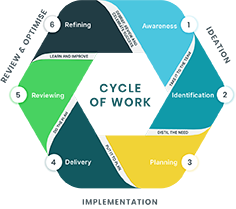 As organisations navigate new ways of working digitally, understanding the cycle of work is essential to deliver innovative and successful work. ASI Solutions has developed an easy-to-implement, six-step methodology to help businesses embrace technology solutions and gain maximum value. This methodology supports organisations to achieve the best outcomes.
As organisations navigate new ways of working digitally, understanding the cycle of work is essential to deliver innovative and successful work. ASI Solutions has developed an easy-to-implement, six-step methodology to help businesses embrace technology solutions and gain maximum value. This methodology supports organisations to achieve the best outcomes.
This blog series explores the various phases within the cycle of work methodology and highlights the ways organisations can benefit from a more strategic approach to digital work.
Step 1: The cycle of work: becoming aware
Businesses are rethinking how they engage with customers and what processes they rely on operationally to deliver on customer demands while keeping costs and complexity to a minimum. With many businesses supporting employees to work from home full-time or some of the time a new set of challenges is created. This includes traditional sources of collaboration or innovation, such as water-cooler conversations, impromptu meetings, and unplanned discussions, no longer being available, which means businesses must create a new way to identify the kernel of an idea. This is the first step in the cycle of work: awareness.
Taking the first step
Awareness refers to the moment that someone in the business identifies a problem to be solved, an idea to be explored, or an improvement to be made. This generally leads to a decision to take it to the team discuss possible solutions or ideas.
The awareness stage requires people in the business to share information with each other to discuss ideas further, which will likely include data collection and analysis. However, when people work from various locations, including their home offices, it can create challenges for collaboration and information sharing. So, teams need to find effective ways to share information without, for example, being able to take an impromptu five minutes in a meeting room together to hash things out.
Instead, organisations can use online meeting tools that let them share knowledge and collaborate in a virtual room together. These tools even let them share documents and work in a way that’s just as collaborative as previous, in-office methods were. Solutions such as Microsoft Dynamics and Microsoft Teams can be extremely useful in this situation.
For example, Microsoft Dynamics as your CRM can help to identify and capture actionable customer insights and potential challenges quickly and easily. In doing so, you can collect and analyse data, gaining deeper insights into the issue. Once you have the information you need to make smart decisions, you can use Microsoft Teams, as well as Microsoft Outlook and other calendar applications, to connect with all the people who have an interest in this project. You can schedule in team meetings and collaborative brainstorming sessions that suit. And, the real-time nature of this process, along with ease of information-sharing, helps you overcome the challenges of not being in the same office or geographic area.

Beware the temptation of perfection
At this stage in the cycle of work, it’s important to actively avoid the perception that ideas are anywhere near complete. Using whiteboarding tools in Microsoft Teams and handwritten concepts can help encourage more robust and wide-ranging feedback that focuses on the idea itself, rather than the details of how that idea has been expressed.
The nature of online meetings means that people generally come to the meeting with some ideas, usually presented in a format such as Microsoft PowerPoint or similar. Unfortunately, this can create a near-sightedness among meeting participants, causing them to focus on the details of a design or grammar in the copy, rather than consider the big picture. Aiming for perfection at this stage can be counterproductive.
The right technology at the right time
Supporting workers with the right technology at the right time can increase the odds of successful outcomes. In the awareness phase, this can include:
- Microsoft Dynamics CRM to collect data, perform analysis, and gain insights
- Microsoft Outlook and Microsoft Teams to set up team meetings that fit with everyone’s calendar
- Microsoft SharePoint and Microsoft OneNote to manage communications including protecting sensitive documents.
Where to from here?
Awareness is just the first step in the cycle of work. To learn more about the cycle of work and the next step in the ASI Solutions methodology for modern work habits and practices, download the eBook.
ASI Solutions aligns directly with Microsoft’s vision of empowering every person and organisation to achieve more. ASI Solutions can coach your business to deliver each step of the cycle of work so you can achieve optimum outcomes. To find out more about how ASI Solutions can help you embrace the modern cycle of work, contact the team today.
